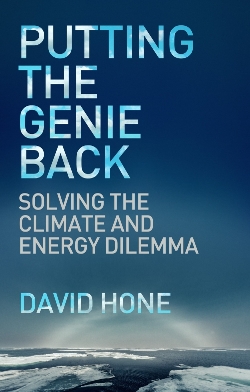 “An uninformed belief is gaining ground and leading to the false conclusion that a very rapid energy transition is underway that will solve the [carbon] emissions issue… [and] … that emissions will fall rapidly and decisively without real financial outlay…” So begins the final chapter of this book by Shell’s Chief Climate Change Advisor, David Hone. In it he argues that the energy transition needed for the 2015 Paris Agreement goal of “well below 2°C” of warming will only happen if driven by carbon emissions pricing in globally linked national or regional schemes, and if there is carbon capture and geological storage (CCS) at vast scale.
“An uninformed belief is gaining ground and leading to the false conclusion that a very rapid energy transition is underway that will solve the [carbon] emissions issue… [and] … that emissions will fall rapidly and decisively without real financial outlay…” So begins the final chapter of this book by Shell’s Chief Climate Change Advisor, David Hone. In it he argues that the energy transition needed for the 2015 Paris Agreement goal of “well below 2°C” of warming will only happen if driven by carbon emissions pricing in globally linked national or regional schemes, and if there is carbon capture and geological storage (CCS) at vast scale.
Hone is perhaps the ultimate insider on climate change, attending many of the major international conferences of the past decade. He nevertheless expresses frustration with the unwillingness of policymakers to tackle head-on the rising concentration of CO2 in the atmosphere, and returns frequently to the notion that cumulative carbon emissions since 1750 should not exceed one trillion tonnes (3.7 trillion tonnes of CO2) and the implication that the great majority of the world’s proven fossil fuel reserves should remain in the ground.
On carbon pricing, his thesis is that existing schemes have been rendered ineffective by overlapping policy initiatives (e.g. renewable energy targets). They thus have negligible effect on CO2 emissions and deliver carbon prices far below the level (about $100/tonne CO2) needed to create a market for CCS. In the absence of a functioning global carbon market, he suggests the development of tradable “CCS credits” to get CCS going at scale.
As an “amateur” observer of the climate change scene, I found little in the book I could take issue with, apart from one statement: “Opting to leave these [fossil fuel] reserves in the ground forever … will happen only if alternative energy sources are developed that out-compete them …”. This makes the assumption that the option to regulate the extraction of fossil fuels (such as through a system of tradeable extraction permits under a 1 trillion tonne cap) has been properly explored and rejected for good reasons. I am not aware that it has. Who knows, might such an approach even result in an effective carbon price that delivers CCS at scale, as well as incentivising renewables and energy efficiency?
One other criticism I would make is that, in almost a throw-away line near the end of the book, Hone implicitly classes CCS and other “negative emissions technologies” (NETs) as “geoengineering” techniques. As others have noted, there is a big difference between techniques that seek to mask the effects of CO2 accumulation in the atmosphere (such as sulphur injection into the stratosphere) and NETs. It may be unhelpful to give all of them the emotive “geoengineering” label.
Given the somewhat dry nature of the subject matter, I found the book mostly a good read, and the most informative account I have read as to how we got to where we are, in terms of both science and policy. I recommend it to anyone who wants to understand current policy responses to climate change, effective or otherwise.
Reviewed by: Hugh Richards
PUTTING THE GENIE BACK: SOLVING THE CLIMATE AND ENERGY DILEMMA by DAVID HONE (Emerald Publishing), 2017, list price £12.99